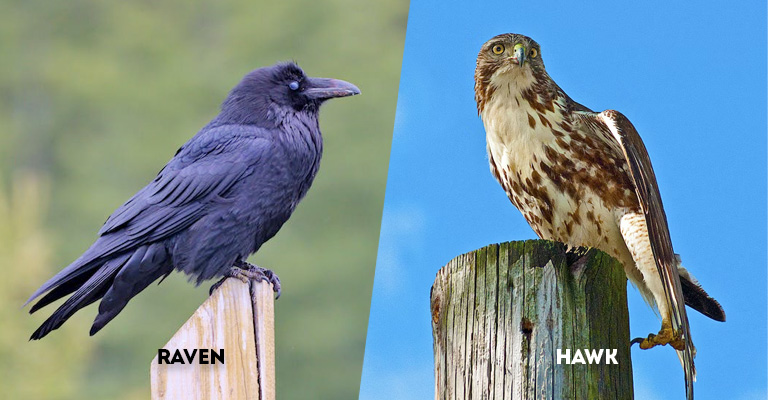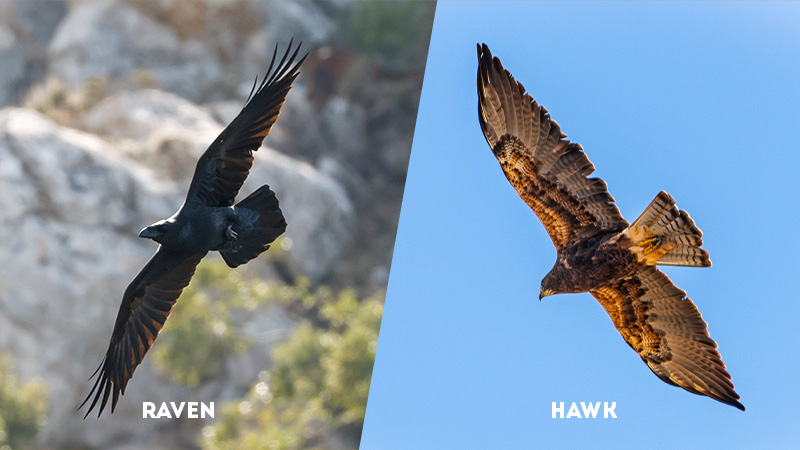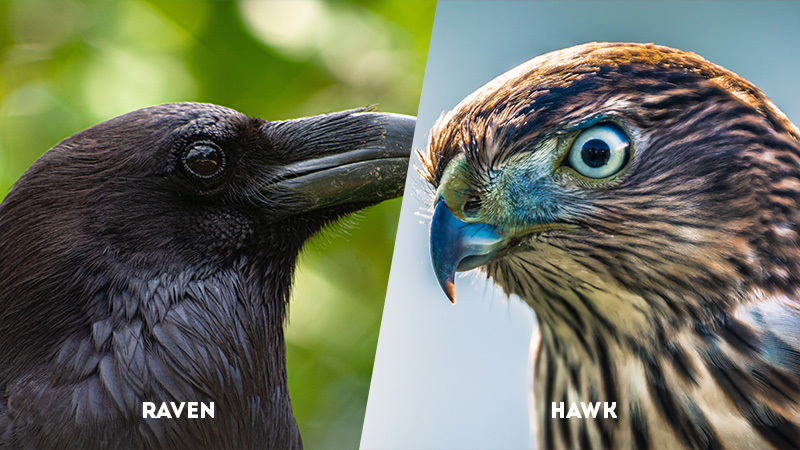Ravens and hawks, two captivating avian species, exhibit a remarkable array of characteristics that make them stand out in the world of birds. While they share the skies as predators, their flight styles, feeding behaviors, and ecological roles diverge significantly.
Ravens, renowned for their intelligence and adaptability, contrast with hawks, which are recognized for their exceptional eyesight and hunting prowess.
This introduction sets the stage to explore the unique attributes that define these birds, delving into their differences in plumage, behavior, habitat, and cultural significance.

Key Differences Between Ravens and Hawks
Ravens and hawks are both birds of prey, but they belong to different genera and have several key differences:
Flight Style

- Raven: Ravens are known for their agile and playful flight maneuvers, characterized by dives, rolls, and loops. Their flight is acrobatic, allowing them to swiftly change direction.
This adaptability suits their opportunistic scavenging behavior and helps them navigate complex environments. - Hawk: Hawks possess a streamlined flight style tailored for efficient hunting. They excel in soaring at high altitudes, utilizing updrafts and thermals to conserve energy while surveying large territories for prey.
Their flight is focused and purposeful, enabling them to spot potential targets from afar and execute precise swoops for capture.
Eyesight

- Raven: Ravens exhibit a good level of eyesight, although it’s not as extraordinary as that of hawks. Their eyesight supports their diverse behaviors, including scavenging, stealing, and interacting socially.
Ravens are opportunistic feeders, often feasting on carrion and utilizing their eyesight to spot potential food sources from a distance. - Hawk: Hawks are renowned for their exceptional eyesight, which plays a pivotal role in their hunting strategies.
Their eyes are equipped with specialized retinas that contain a high density of photoreceptor cells, enhancing their ability to perceive fine details and movements even from great distances.
Hearing
- Raven: Ravens have excellent hearing capabilities that complement their scavenging and social behaviors. They are known to mimic sounds, which indicates their auditory acumen.
This sharp sense of hearing assists them in detecting potential threats, such as the approach of predators or other dangers, helping them take evasive actions when necessary. - Hawk: While hawks primarily rely on their exceptional eyesight, they also possess keen hearing abilities. Their auditory senses allow them to detect high-pitched sounds and subtle noises, aiding them in locating prey that might be hidden from sight.
Though not as emphasized as their vision, their hearing serves as an additional tool that enhances their overall hunting efficiency.
Sensory Adaptations
- Raven: Ravens have evolved with sharp eyesight and acute hearing to survive in various environments. These sensory adaptations are well-suited to their versatile foraging habits, allowing them to detect both potential sources of food and signs of danger.
The combination of these senses aids ravens in maintaining situational awareness and navigating their surroundings effectively. - Hawk: Hawks’ primary sensory adaptation is their extraordinary vision, finely tuned for spotting prey from great heights. Their retinas are designed to capture the maximum amount of light, enhancing their ability to see details in varying lighting conditions.
This sensory specialization aligns with their predatory lifestyle, providing them with the advantage needed to track, pursue, and capture their elusive prey.
Intelligence
- Raven: Ravens are known for their high intelligence and problem-solving abilities. They have demonstrated skills such as using tools, solving puzzles, and even planning for future needs.
Their intelligence is intertwined with their scavenging behavior, enabling them to find innovative ways to access food sources and adapt to changing environments. - Hawk: Hawks prioritize their hunting prowess over complex problem-solving. Their intelligence is honed for efficient hunting strategies, often relying on stealth, speed, and precision in their pursuits.
While not as renowned for cognitive feats as ravens, hawks excel in their specialized area of expertise – locating, targeting, and capturing live prey with remarkable accuracy.
Feeding Behavior
- Raven: Ravens are opportunistic feeders with a versatile diet. They scavenge for carrion, raid the nests of other birds, steal food from predators, and consume a wide range of items including insects, fruits, and small animals.
Their ability to adapt their feeding behavior allows them to thrive in diverse environments and take advantage of available resources. - Hawk: Hawks are skilled hunters with a carnivorous diet. They predominantly hunt live prey, using their sharp talons to capture animals such as rodents, birds, and even larger prey like rabbits.
Hawks employ various hunting techniques, including high-speed aerial pursuits and perching to observe potential prey from a distance before striking.
Food Source
- Raven: Ravens have a scavenging approach to finding food. They are often associated with consuming carrion, making them nature’s cleanup crew.
Additionally, they are known to steal food from other birds, particularly when the opportunity arises, showcasing their opportunistic feeding behavior. - Hawk: Hawks rely on hunting for their food. They are apex predators in their ecosystems, seeking out live prey to sustain themselves.
This diet is a reflection of their exceptional hunting skills and specialized adaptations for capturing and consuming various types of animals.
Vocalizations
- Raven: Ravens are highly vocal birds with a diverse range of calls. Their vocalizations include croaks, caws, and various other sounds.
They even possess the ability to mimic human speech and imitate sounds from their surroundings. Ravens use vocalizations for communication within their social groups and to establish territories. - Hawk: Hawks are generally less vocal than ravens. Their calls are often sharp and distinctive, serving communication purposes such as identifying their presence or marking territories.
While their vocal range may not be as varied as that of ravens, their calls play a crucial role in their interactions and signaling to other hawks.
Social Behavior
- Raven: Ravens are social birds that can form complex relationships within their groups. They engage in playful behaviors, aerial acrobatics, and even cooperative hunting.
Ravens have been observed forming strong bonds with mates and working together to solve challenges, showcasing their capacity for social interaction. - Hawk: Hawks are more commonly found in solitary or pair-bonded arrangements. They exhibit territorial behavior and often defend their hunting grounds from other hawks.
While they may interact during mating and breeding seasons, hawks generally exhibit less complex social behaviors compared to ravens.
Size
- Raven: Ravens are generally larger and more robust than many hawk species. Their size varies among different species, but they tend to have a larger physical presence, which can aid them in their scavenging and opportunistic feeding habits.
- Hawk: Hawks come in various sizes, ranging from smaller species like the Sharp-shinned Hawk to larger ones like the Red-tailed Hawk.
While there’s variation, hawks are typically smaller than ravens. Their size is well-suited to their hunting strategies, allowing them to efficiently pursue and capture their prey.
Plumage
- Raven: Ravens typically have glossy black plumage that may have variations in shades and highlights depending on lighting. Their feathers can appear iridescent and display subtle hues of blue, purple, or green when viewed from certain angles.
- Hawk: Hawks exhibit a wide range of plumage colors and patterns based on their species. Their plumage can vary from shades of brown and gray to reddish-brown and even white. These variations often serve as camouflage, aiding hawks in blending into their respective habitats.
Nesting
- Raven: Ravens build large stick nests, often located in trees or on cliffs. They construct substantial nests that can be reused for multiple years. Ravens may also nest in urban environments, using structures like telephone poles and buildings.
- Hawk: Hawks also build nests, but their nests are usually smaller than those of ravens. They create nests using sticks, twigs, and other materials in trees or on ledges. The size and location of hawk nests vary among species and habitats.
Territorial Behavior
- Raven: Ravens defend territories, but their territorial behavior might be more loosely defined compared to some hawk species. They can form loose social groups, and while territorial disputes occur, they also engage in cooperative behaviors such as group feeding.
- Hawk: Hawks are often more vigorously territorial. They fiercely defend their hunting territories from intruders, especially other hawks. Hawk species can have well-defined territories that they protect against other individuals of the same species.
Hunting Strategy
- Raven: Ravens are opportunistic scavengers and predators. Their hunting strategies involve observing other predators, such as wolves or foxes, to locate potential food sources. They are known to steal food from other birds and animals.
- Hawk: Hawks are skilled hunters who employ a range of strategies depending on their species and prey. Many hawks hunt from perches or soar at high altitudes, scanning the ground for movement. They then use their speed and agility to make precise strikes on their prey.
Preferred Prey
- Raven: Ravens have a diverse diet that includes scavenged carrions, insects, fruits, small animals, and even human food scraps. Their opportunistic feeding behavior allows them to exploit a wide range of available resources.
- Hawk: Hawks primarily prey on live animals. Their diet consists of small to medium-sized mammals like rodents, birds, and sometimes reptiles. Their hunting prowess and sharp talons enable them to capture and consume a variety of prey items.
Migration Patterns
- Raven: Ravens have varied migration patterns depending on the species and location. Some raven populations are known to undertake seasonal migrations, while others are more sedentary and remain in their territories year-round. Migration can be influenced by factors such as food availability and climate.
- Hawk: Migration patterns among hawk species also vary. Some hawks are migratory, traveling long distances between breeding and wintering grounds.
Others are resident birds that stay in their habitats throughout the year. The decision to migrate or not is influenced by factors like prey availability and environmental conditions.
Range
- Raven: Ravens have a broad range and can be found in diverse habitats across North America, Europe, Asia, and other regions. They adapt well to various environments, from forests to grasslands to urban areas.
- Hawk: Hawks have a global distribution, inhabiting different continents and ecosystems. They are found in a variety of habitats, including forests, grasslands, deserts, and mountains. The range of hawk species varies based on their specific ecological requirements.
Lifespan
- Raven: The lifespan of ravens varies by species and environmental factors. On average, ravens can live around 10 to 15 years in the wild, although some individuals can live longer in favorable conditions.
- Hawk: Hawk lifespans also vary by species and circumstances. In the wild, hawks generally have lifespans of around 10 to 20 years, depending on factors such as predation, food availability, and environmental conditions.
Cultural Significance
- Raven: Ravens hold cultural significance in various cultures around the world. They are often associated with intelligence, mystery, and transformation. In some mythologies and folklore, ravens are portrayed as messengers, tricksters, or symbols of death and rebirth.
- Hawk: Hawks are symbolically significant in many cultures. They often represent qualities such as freedom, nobility, and vision. Hawks’ keen eyesight has led to their association with insight and perception, making them symbols of heightened awareness and intuition.
Conservation Status
- Raven: Raven species, in general, are not considered threatened and are classified as species of least concern. Their adaptability to different environments and their opportunistic feeding habits contribute to their stable populations.
- Hawk: The conservation status of hawk species varies widely. While some hawk populations are stable, others may face threats due to habitat loss, hunting, and environmental changes.
Certain hawk species are classified as endangered or vulnerable, prompting conservation efforts to protect their habitats and populations.
Raven Vs Hawk: Comparison Table
| Feature | Ravens | Hawks |
|---|---|---|
| Flight Style | Agile and acrobatic flight; playful maneuvers | Streamlined flight with soaring and focused hunting |
| Eyesight | Good eyesight; not as exceptional as hawks | Exceptional eyesight; keen ability to spot prey |
| Hearing | Excellent hearing; can mimic sounds | Sharp hearing, used in combination with vision |
| Sensory Adaptations | Sharp eyesight and hearing for detecting threats | Highly developed vision for hunting |
| Intelligence | Intelligent; problem-solving abilities | Focused on hunting and stealth tactics |
| Feeding Behavior | Opportunistic scavengers; steal from predators | Skilled hunters; capture live prey from above |
| Food Source | Carrion, stolen food, scavenging | Live prey, captured with sharp talons |
| Vocalizations | Varied vocalizations; capable of mimicking sounds | Distinctive calls for communication and hunting |
| Social Behavior | Can be social; form complex relationships | Solitary or in pairs; territorial behavior |
| Size | Generally larger; more robust physique | Varies among species; generally smaller than ravens |
| Plumage | Glossy black with some variations | Varied colors and patterns based on species |
| Nesting | Build large stick nests; often in trees | Construct nests in trees or on ledges |
| Territorial Behavior | Defend territories; may form loose groups | Defend territories vigorously |
| Hunting Strategy | Scavenge, steal, follow predators | Hunt with stealth and speed |
| Preferred Prey | Omnivorous; eat various foods, including carrion | Carnivorous; prey on smaller animals |
| Migration Patterns | Some species migrate seasonally | Some species migrate, others are year-round residents |
| Range | Wide distribution; found across various habitats | Range depends on species; adapt to diverse habitats |
| Lifespan | Varies by species; generally around 10-15 years | Varies by species; generally 10-20 years |
| Cultural Significance | Symbolic in various cultures; associated with death | Symbolic of power, freedom, and nobility |
| Conservation Status | Generally not threatened; adaptable species | Varies by species; some are endangered |
Frequently Asked Questions
Yes, there can be interactions between ravens and hawks, especially when it comes to food. Ravens are known to scavenge from hawk kills or steal their prey.However, hawks are generally more focused on live hunting, so direct competition might be less common than scavenging incidents.
While they are different species, both ravens and hawks have distinct calls and vocalizations that serve communication purposes within their own species.It’s unlikely that they communicate directly with each other, as their vocalizations are tailored to their specific behaviors and social interactions.
Some species of hawks, such as the Philippine Eagle and the Hawaiian Hawk, are considered endangered due to habitat loss and human activities. Among ravens, the Chihuahuan Raven is listed as a species of concern in the United States due to its limited distribution.
While both ravens and hawks are predators themselves, they can have predators at different life stages. For example, the eggs and young of both species can be vulnerable to predation by larger birds, mammals, and even other predators within their ecosystems.
Yes, both ravens and hawks have demonstrated adaptability to urban environments. Ravens are often seen in urban areas scavenging for food, while some hawk species, like the Red-tailed Hawk, have successfully adapted to cityscapes and can be found nesting on tall buildings and structures.
To Recap
The captivating world of ravens and hawks unveils a rich tapestry of diversity in the avian realm. These two species, while sharing common aerial territory, exhibit distinctive adaptations that suit their specific lifestyles.
From the agile flight of ravens to the precision of hawks’ hunting strategies, their differences illuminate the intricate balance of nature. Their roles, from scavengers to apex predators, showcase the complexities of ecological niches.
Through their unique plumage, behaviors, and interactions with human culture, ravens and hawks remind us of the wondrous variety that defines our natural world.